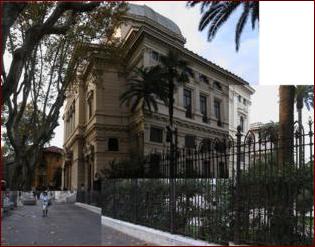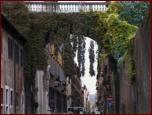|
|
 subscribe
subscribe
|
 subscribe subscribe
|

Bocca Verità |
. . . . . . . . . . . . . . . . . . . . . . . . . . . . . . . . . . . . . . . . . . |
2000 Italia: Piazza Bocca Della Verità (Mouth of Truth)
The Piazza Bocca Della Verità (Mouth of Truth) is just across the Tiber River from the Trastevere neighborhood via the Ponte Palatino, just a short walk southwest from Campo dé Fiori, south of the Foro Romano (Roman Forum) and the Colosseo (Coliseum). Here we found two echoes of ancient Roma: the Chiesa di (Church of) S.Maria in Cosmedin and the Circo Massimo.
   Done with this part of town we turn around, walking the Lungotevere Pierleoni along the river. It's not a long walk to synagogue, shown here, at left. It's hard to see the two armed police in front of the building. They were a sad, clueless lot. They didn't seem to realize that the synagogue they were guarding was open, but that the entrance was in the back. It was Friday afternoon, and we'd planned on being here to participate in sabbath services. We continued to the side of the building, past the anti-terrorist crash barriers, to the rear entry. A squad of police was checking those requesting entry. Our bags weren't allowed in, so we took turns guarding our pile of backpacks (not that we really were worried about someone taking them under guard; we were more worried about scaring the police). The interior of the synagogue is just beautiful; several stories of Sephardic (Mediterranean/African Jewery) architecture. Services were just starting, and Isaac was outside, so we only spent a short time enjoying the melodies and fine dress of the congregants.
Done with this part of town we turn around, walking the Lungotevere Pierleoni along the river. It's not a long walk to synagogue, shown here, at left. It's hard to see the two armed police in front of the building. They were a sad, clueless lot. They didn't seem to realize that the synagogue they were guarding was open, but that the entrance was in the back. It was Friday afternoon, and we'd planned on being here to participate in sabbath services. We continued to the side of the building, past the anti-terrorist crash barriers, to the rear entry. A squad of police was checking those requesting entry. Our bags weren't allowed in, so we took turns guarding our pile of backpacks (not that we really were worried about someone taking them under guard; we were more worried about scaring the police). The interior of the synagogue is just beautiful; several stories of Sephardic (Mediterranean/African Jewery) architecture. Services were just starting, and Isaac was outside, so we only spent a short time enjoying the melodies and fine dress of the congregants. We were getting good and hungry, so (skipping the kosher full-service restaurant because it was closed) we visited a pizzeria in the Jewish Ghetto, the neighborhood directly behind the synagogue. Sardine pizza. Excellent. Then we stopped at a café next door, had another caffè macciati caldo, and returned to the river. A few blocks north, at the place where we see the plants overhanging the street, we turn toward the Campo dé Fiori and home. To sleep, perchance to dream.
We were getting good and hungry, so (skipping the kosher full-service restaurant because it was closed) we visited a pizzeria in the Jewish Ghetto, the neighborhood directly behind the synagogue. Sardine pizza. Excellent. Then we stopped at a café next door, had another caffè macciati caldo, and returned to the river. A few blocks north, at the place where we see the plants overhanging the street, we turn toward the Campo dé Fiori and home. To sleep, perchance to dream.
|
| Have you found errors nontrivial or marginal, factual, analytical and illogical, arithmetical, temporal, or even typographical? Please let me know; drop me email. Thanks! |